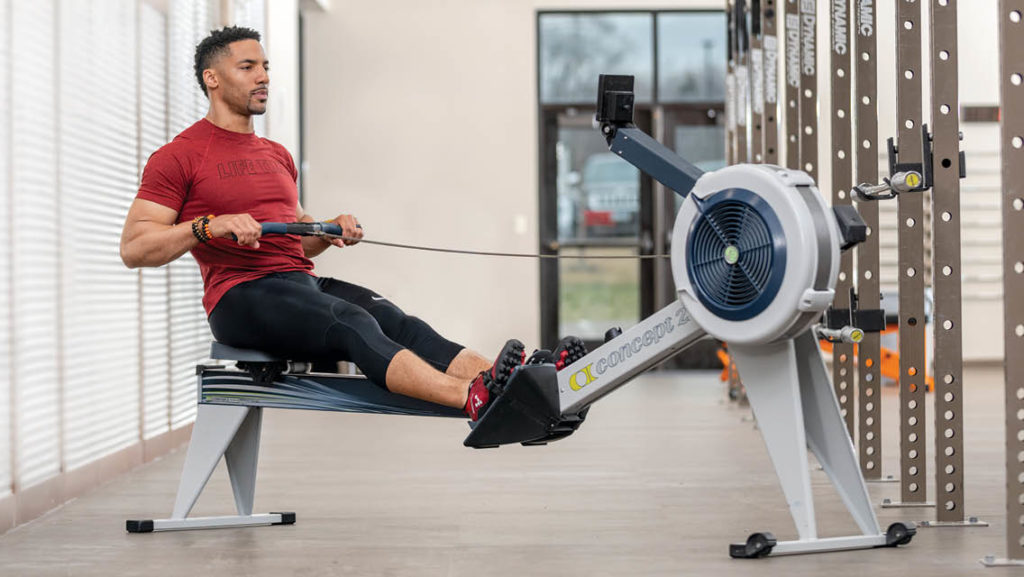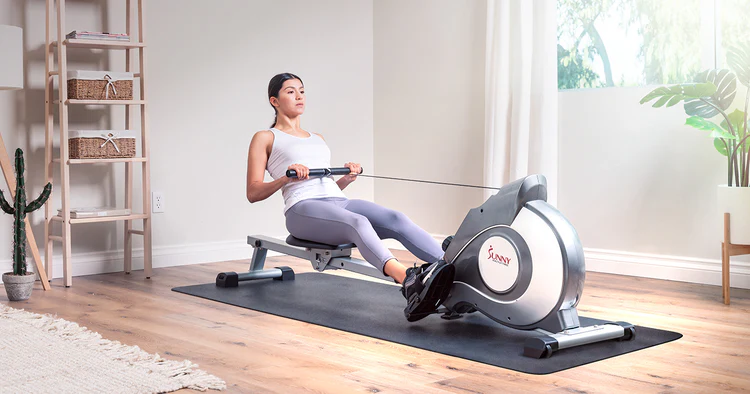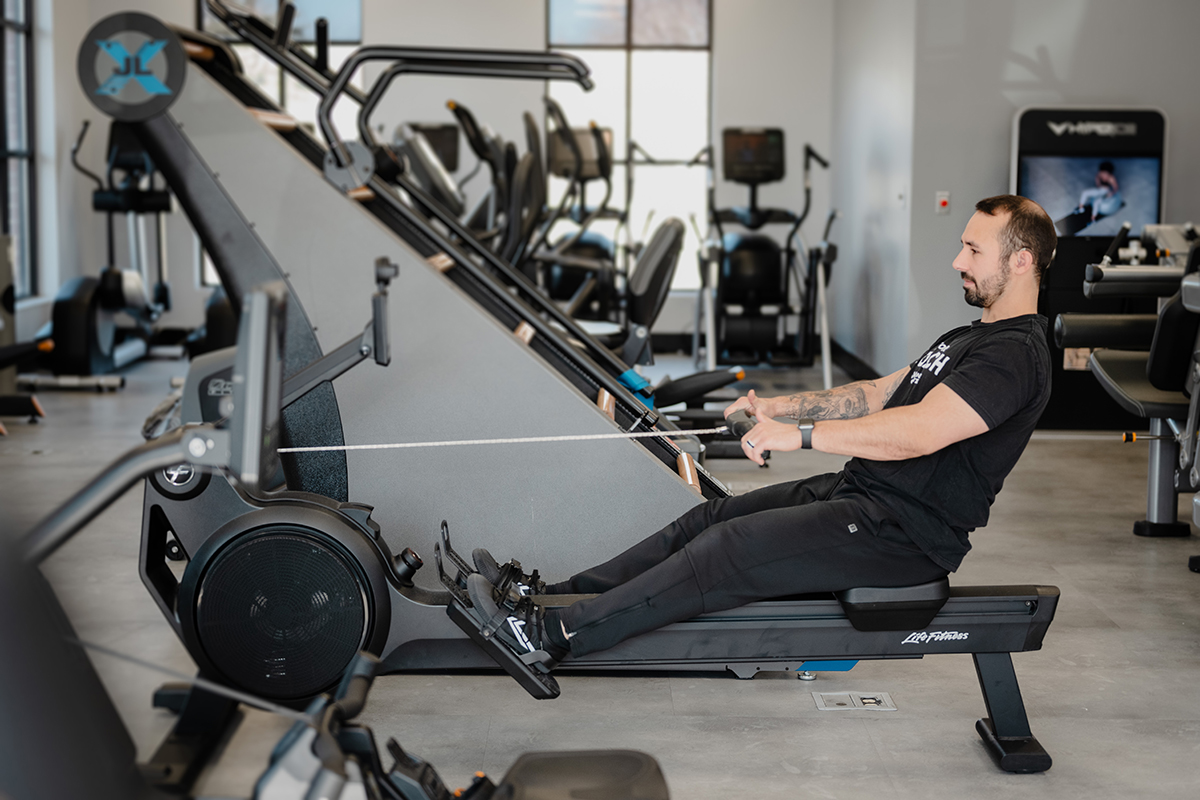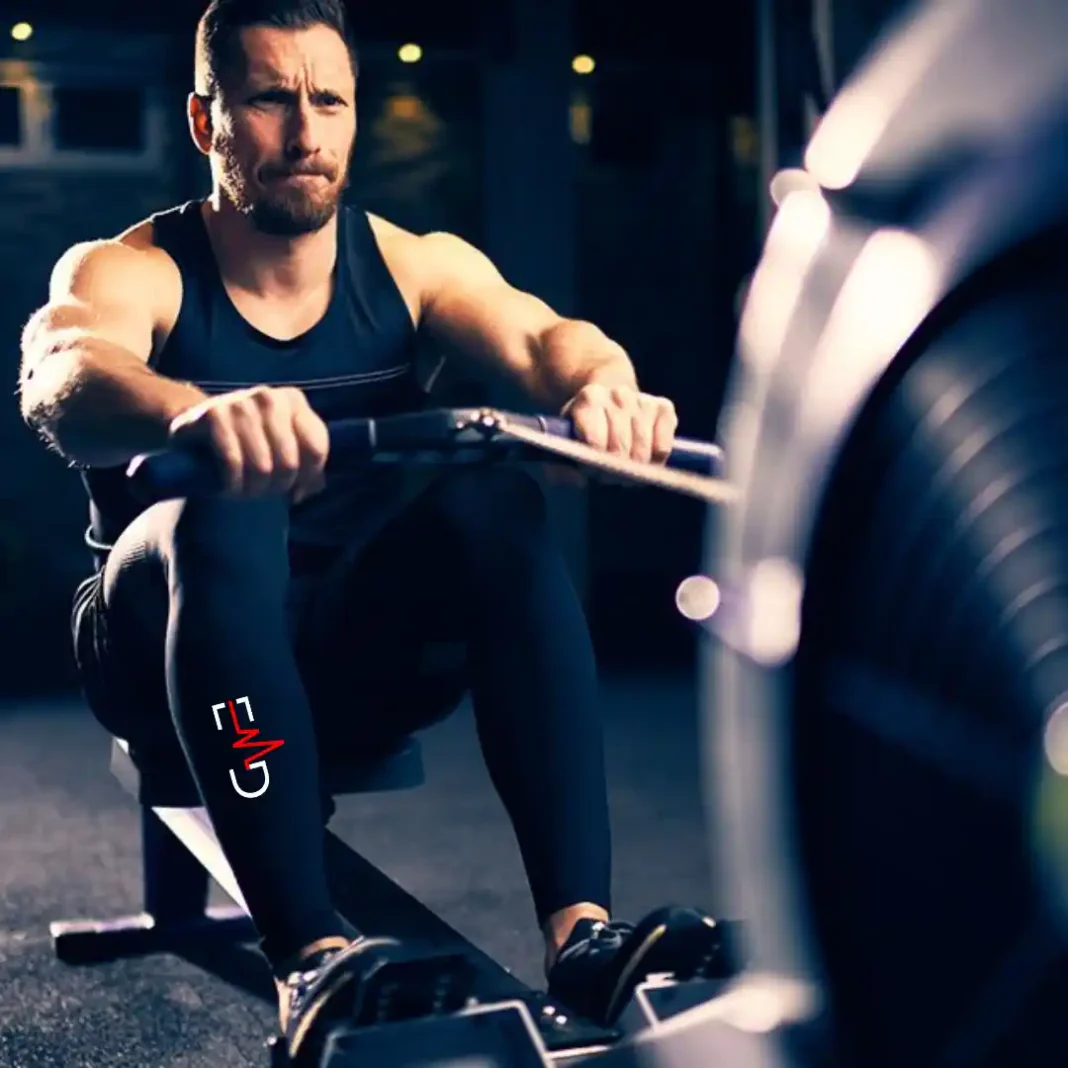Exercise Daily – Rowing transcends being merely a water sport or a conventional gym activity; it is a comprehensive workout regimen that simultaneously enhances cardiovascular health and fortifies muscular strength. Whether you’re gliding across serene waters or harnessing the power of a rowing machine indoors, rowing offers a dynamic approach to fitness that targets multiple facets of your physical well-being in a single session.
For fitness enthusiasts aiming to harmonize cardio with strength training, rowing presents an unparalleled full-body workout. It engages the core, arms, legs, and back, ensuring that no major muscle group is left untouched. This multifaceted engagement promotes balanced muscle development and optimizes calorie expenditure, making rowing an efficient choice for those with busy schedules.
Benefits of Rowing Machine Workouts
Rowing seamlessly integrates aerobic and anaerobic training, offering the dual benefit of enhancing cardiovascular health while building muscle endurance. This dual-action nature sets rowing apart from many other forms of exercise, providing a holistic approach to fitness.
Low-Impact Yet Intense
One of the standout advantages of rowing is its low-impact nature. Unlike high-impact activities such as running or jumping, rowing minimizes joint stress, making it an excellent option for individuals seeking a rigorous workout without the associated joint strain. This makes rowing suitable for a broad spectrum of individuals, including those recovering from injuries or those with joint sensitivities.
Comprehensive Muscle Engagement
Rowing is a full-body exercise that demands the coordinated effort of multiple muscle groups. This comprehensive engagement accelerates calorie burn and enhances muscular coordination and overall strength. The rhythmic nature of rowing ensures that muscles across the body are in harmony, promoting balanced muscle development and reducing the risk of muscular imbalances.
Calorie-Burning Efficiency
Due to the involvement of both the upper and lower body, rowing is highly effective in burning calories. Whether you aim for weight loss, maintenance, or muscle gain, rowing can be tailored to meet your specific caloric expenditure goals. The intensity and duration of your rowing sessions can be adjusted to align with your fitness objectives, making it a versatile tool in your fitness journey.

Why Rowing is Excellent for Cardiovascular Health
Rowing is renowned for its ability to deliver substantial cardiovascular benefits. As a full-body exercise, it places significant demands on the heart and lungs, leading to enhanced heart rate and lung capacity over time.
Enhanced Heart and Lung Function
Regular rowing workouts stimulate the heart to pump more efficiently, improving cardiovascular endurance. The consistent rowing rhythm elevates the heart rate, fostering stronger cardiac muscles and improving overall heart health. Simultaneously, the increased demand for oxygen during rowing enhances lung capacity, allowing your body to utilize oxygen more effectively during both exercise and rest.
Improved Oxygen Utilization
Rowing demands a higher oxygen intake due to the extensive muscle engagement involved. This increased oxygen utilization boosts your cardiovascular endurance and enhances your body’s ability to perform sustained physical activity without undue fatigue. Over time, this leads to improved stamina and a more resilient cardiovascular system.
The Science Behind Rowing and Cardio
Rowing is primarily a cardiovascular powerhouse because it engages large muscle groups. Each rowing stroke involves a coordinated effort from the legs, back, core, and arms, significantly increasing heart rate. This sustained elevation in heart rate trains the cardiovascular system to become more efficient, akin to the benefits derived from running or cycling, but with the added advantage of reduced impact on the body.
The continuous motion of rowing ensures that the heart remains elevated for extended periods, fostering endurance and resilience. Additionally, the rhythmic nature of rowing can lead to improved mental focus and stress reduction, further contributing to overall cardiovascular health.
Rowing vs. Other Cardio Workouts
Compared to traditional cardio workouts such as running or cycling, rowing offers several distinct advantages, making it a superior choice for many fitness enthusiasts.
Higher Calorie Burn in Less Time
Due to the involvement of both the upper and lower body, rowing can burn more calories in a shorter period compared to exercises that engage only one part of the body. This makes rowing an efficient option for those looking to maximize their calorie expenditure within limited workout timeframes.
Superior Muscle Engagement
While running primarily targets the lower body, rowing ensures comprehensive muscle engagement across the entire body. This enhances overall strength and promotes balanced muscle development, reducing the likelihood of muscular imbalances that can arise from repetitive, single-focus exercises.
Comparing Calorie Burn and Muscle Engagement
Research indicates that a 30-minute rowing workout can burn between 200-300 calories, contingent upon the workout’s intensity and the individual’s body weight and metabolism. In contrast, running may burn similar calories but typically engages fewer muscle groups. Additionally, rowing strengthens the back, arms, and core alongside the legs, providing a more well-rounded muscular workout that supports overall fitness and functional strength.
Moreover, integrating both aerobic and anaerobic elements in rowing ensures that you’re not only burning calories but also building muscle, making it an ideal choice for those seeking comprehensive fitness benefits.

Rowing Workout 1: Steady-State Cardio Row
A steady-state row is an excellent starting point for building cardiovascular endurance. This workout focuses on maintaining a consistent pace and rhythm, allowing you to develop endurance without excessive fatigue.
Workout Structure
- Duration: 20-30 minutes
- Resistance Level: Moderate (adjust based on fitness level)
- Stroke Rate: 22-24 SPM
- Focus: Rhythm, breathing, and maintaining a steady pace
Execution
- Warm-Up: Begin with a 5-minute warm-up at a low resistance and slow stroke rate to prepare your muscles and cardiovascular system.
- Main Session: Set the resistance to a moderate level where you can maintain a conversation without gasping for breath. Focus on a consistent stroke rate, ensuring each stroke is smooth and controlled.
- Cool-Down: Conclude with a 5-minute cool-down at a lower resistance and slower stroke rate to lower your heart rate gradually and aid in muscle recovery.
Benefits
- Improved Cardiovascular Health: Sustained rowing steadily enhances heart and lung efficiency.
- Enhanced Endurance: Builds the stamina required for longer-duration activities and overall fitness.
- Calorie Burning: Consistent effort over time leads to significant calorie expenditure, supporting weight management goals.
Rowing Workout 2: Interval Training for Strength and Cardio
Interval training is a dynamic approach that alternates between periods of high-intensity rowing and rest or low-intensity rowing. This method effectively combines strength and cardio, promoting both muscular and cardiovascular adaptations.
Workout Structure
- Duration: 20-30 minutes
- Intervals: 30 seconds of high-intensity rowing, followed by 30 seconds rest
- Rounds: 10-15 rounds
- Total Time: Approximately 15-20 minutes of high-intensity effort
Execution
- Warm-Up: Start with a 5-minute warm-up at a low to moderate intensity to prepare your body for high-intensity efforts.
- Intervals: Row at maximum effort for 30 seconds, pushing your pace and resistance to simulate sprinting. Immediately follow with 30 seconds of rest or slow rowing to recover.
- Repeat: Continue the cycle for 10-15 rounds, depending on your fitness level and endurance.
- Cool-Down: Finish with a 5-minute cool-down at a low intensity to aid in recovery.
Benefits
- Enhanced Cardiovascular Fitness: High-intensity intervals challenge the heart and lungs, leading to improved cardiovascular efficiency.
- Increased Muscle Endurance: The alternating effort levels engage and fatigue muscles, promoting endurance and strength.
- Time Efficiency: Achieves substantial fitness gains in a shorter timeframe than steady-state workouts.
High-Intensity Intervals Explained
Intervals create a stress-recovery cycle that pushes your cardiovascular and muscular systems to adapt and improve. During high-intensity phases, your body taps into anaerobic energy systems, building power and speed. The subsequent rest periods allow partial recovery, enabling you to sustain higher overall effort levels throughout the workout.
This method maximizes calorie burn and stimulates muscle growth and improves metabolic rate, making it an effective strategy for overall fitness enhancement.
Rowing Workout 3: Pyramid Workout for Endurance
A pyramid workout introduces variability in rowing duration, incrementally increasing and then decreasing the rowing time. This structure challenges your stamina and keeps the workout engaging by introducing changes in intensity and rest periods.
Workout Structure
- Duration: 30-40 minutes
- Structure: Ascending and descending intervals (e.g., 1 minute, 2 minutes, 3 minutes, then back down)
- Resistance Level: Moderate to high
- Stroke Rate: Varies with each interval
Execution
- Warm-Up: Engage in a 5-minute warm-up at a low resistance and steady pace to prepare your muscles.
- Ascending Pyramid:
- Row for 1 minute at a high stroke rate and moderate resistance.
- Rest for 1 minute.
- Row for 2 minutes, increasing intensity slightly.
- Rest for 1 minute.
- Row for 3 minutes, pushing your endurance.
- Descending Pyramid:
- Row for 2 minutes, maintaining intensity.
- Rest for 1 minute.
- Row for 1 minute, increasing stroke rate.
- Rest for 1 minute.
- Cool-Down: Conclude with a 5-minute cool-down at a lower resistance and slower pace.
Benefits
- Builds Stamina: The varying intervals challenge your endurance, promoting sustained effort over longer periods.
- Prevents Monotony: The changing durations keep the workout interesting, reducing the likelihood of boredom.
- Enhances Mental Toughness: Navigating through increasing and decreasing intervals builds mental resilience and focus.
Progression Tips
As your endurance improves, consider increasing the duration of each interval or the overall number of pyramid levels. Additionally, you can adjust the resistance to match your enhanced stamina, ensuring continuous progression and challenge.

Rowing Workout 4: Sprint Rowing for Power
Sprint rowing focuses on short, intense bursts of effort, emphasizing power and muscular strength. This workout is ideal for those looking to build explosive strength and improve their overall rowing speed.
Workout Structure
- Duration: 20-25 minutes
- Intervals: 15-20 seconds of maximum effort rowing, followed by 1 minute of rest
- Rounds: 10-12 rounds
- Resistance Level: High during sprints, low during rest
- Stroke Rate: Maximum during sprints
Execution
- Warm-Up: Start with a 5-minute warm-up at a low to moderate intensity to prepare your muscles for high-intensity efforts.
- Sprint Intervals:
- Row as hard and fast as possible for 15-20 seconds, focusing on powerful strokes and explosive movements.
- Follow with 1 minute of rest or very slow rowing to allow for adequate recovery.
- Repeat: Continue the cycle for 10-12 rounds, adjusting the number of sprints based on your fitness level.
- Cool-Down: End with a 5-minute cool-down at a low intensity to aid in muscle recovery.
Benefits
- Increased Power and Strength: High-intensity sprints engage fast-twitch muscle fibers, promoting muscle growth and explosive strength.
- Enhanced Speed: Sprint training improves your ability to row faster, translating to better performance in competitive rowing or other sports.
- Boosted Metabolism: The intense effort spikes your metabolic rate, leading to increased calorie burn even after the workout concludes.
Technique Tips for Sprint Rowing
- Explosive Drive: Focus on a powerful leg push and a swift, controlled arm pull to maximize each sprint’s effectiveness.
- Breathing: Coordinate your breathing with your strokes to maintain oxygen supply and prevent early fatigue.
- Recovery: Utilize the rest periods to recover fully, ensuring that each sprint is performed with maximum effort and proper form.
Rowing Workout 5: 10-Minute Full-Body Blast
For those pressed for time, a 10-minute full-body blast offers a quick yet effective workout that targets multiple muscle groups while delivering substantial cardio benefits.
Workout Structure
- Duration: 10 minutes
- Format: Continuous rowing with varying intensities
- Resistance Level: Challenging yet manageable
- Stroke Rate: Consistent, with brief spikes for added intensity
Execution
- Warm-Up: Spend 1-2 minutes rowing at a low intensity to prepare your body.
- Main Session:
- Row continuously for 10 minutes, maintaining a brisk pace.
- Incorporate brief 10-15 second spikes of increased intensity every 2 minutes to elevate your heart rate and engage more muscle fibers.
- Cool-Down: Finish with a brief 1-2 minute cool-down at a slower pace to stabilize your heart rate.
Benefits
- Time Efficiency: Achieves a comprehensive workout in a minimal timeframe, making it ideal for busy schedules.
- Full-Body Engagement: Targets all major muscle groups, ensuring a balanced workout.
- Cardio Boost: Maintains a high heart rate, promoting cardiovascular health and calorie burn.
Maximizing the 10-Minute Workout
To enhance the effectiveness of this short workout, focus on maintaining proper form and consistent intensity. Even within the limited time, the quality of each stroke matters significantly in delivering maximum benefits.
Rowing Workout 6: Low-Impact Row for Recovery
Recovery days are crucial for muscle repair and overall fitness progression. A low-impact row serves as an active recovery workout, maintaining cardio fitness without imposing significant strain on the muscles and joints.
Workout Structure
- Duration: 15-20 minutes
- Resistance Level: Low to moderate
- Stroke Rate: Slow and controlled
- Focus: Gentle rowing, breathing, and muscle relaxation
Execution
- Warm-Up: Begin with a 3-4 minute warm-up at a very low intensity to ease your body into movement.
- Main Session:
- Row at a comfortable pace, focusing on smooth, controlled strokes.
- Maintain a low resistance setting to minimize muscle strain while keeping the heart rate elevated.
- Concentrate on deep, rhythmic breathing to promote relaxation and oxygen flow.
- Cool-Down: Conclude with a 3-4 minute cool-down, gradually reducing your rowing pace to reduce your heart rate.
Benefits
- Muscle Recovery: Low-intensity rowing promotes blood flow to muscles, aiding in removing metabolic waste and delivering nutrients for repair.
- Maintained Cardio Fitness: Keeps the cardiovascular system engaged without overtaxing it, ensuring consistent progress.
- Stress Reduction: The rhythmic and controlled nature of low-impact rowing can help reduce stress and promote mental well-being.
Additional Recovery Tips
Incorporate stretching or mobility exercises post-rowing to enhance muscle recovery further. Staying hydrated and ensuring adequate nutrition also support the recovery process.
Rowing Workout 7: Mixed Cardio and Strength Routine
A mixed cardio and strength routine combines rowing with bodyweight exercises, creating a balanced workout targeting cardiovascular and muscular fitness.
Workout Structure
- Duration: 20-30 minutes
- Format: Alternating rowing and strength exercises
- Resistance Level: Moderate to high on the rowing machine
- Strength Exercises: Push-ups, squats, lunges, planks, etc.
- Stroke Rate: Varies between rowing and strength intervals
Execution
- Warm-Up: Start with a 5-minute warm-up row at a low to moderate intensity.
- Main Session:
- Rowing Interval: Row vigorously for 2 minutes, maintaining a high stroke rate.
- Strength Interval: Immediately transition to bodyweight exercises (e.g., 1 minute of push-ups followed by 1 minute of squats).
- Repeat: Alternate between rowing and strength exercises for a total of 20 minutes.
- Cool-Down: End with a 5-minute cool-down row at a slower pace and light stretching.
Benefits
- Comprehensive Fitness: Engages cardiovascular and major muscle groups, promoting overall fitness.
- Variety: Combining different exercises keeps the workout engaging and prevents plateauing.
- Enhanced Calorie Burn: Alternating between cardio and strength exercises elevates the metabolic rate, maximizing calorie expenditure.
Customization Options
Adjust the duration and intensity of each interval based on your fitness level. Incorporate different bodyweight exercises to target various muscle groups and maintain workout diversity.

Conclusion
Rowing offers a unique and powerful blend of cardio and strength training, positioning it as one of the most effective exercises for achieving a balanced and comprehensive fitness routine. Whether you’re a novice embarking on your fitness journey or a seasoned athlete seeking to elevate your performance, incorporating rowing into your regimen can lead to significant health and strength benefits.
By leveraging the versatility of the rowing machine, you can target multiple muscle groups, enhance cardiovascular endurance, and burn calories efficiently—all within a single, cohesive workout. The seven rowing workouts outlined in this guide cater to various fitness levels and goals, ensuring that there’s a suitable option for everyone.
FAQs – Rowing Workouts for Cardiovascular Health
Q: Is rowing better than running for cardio?
A: Rowing offers a low-impact, full-body workout that engages more muscle groups than running, primarily targeting the lower body. This comprehensive engagement can lead to a higher calorie burn and improved muscle tone. Additionally, rowing reduces the risk of joint strain, making it a suitable alternative for those with joint sensitivities or injuries.
Q: How long should a rowing workout be for cardiovascular health?
A: A 20-30 minute steady-state row is ideal for reaping cardiovascular benefits. This duration allows for sustained effort, enhancing heart and lung function without overexertion. Aim to incorporate rowing sessions 3-4 times per week for optimal results, adjusting the intensity and duration based on your fitness level and goals.
Q: Can rowing help with weight loss?
A: Yes, rowing is highly effective for weight loss. It burns many calories due to the full-body engagement and can be tailored to various intensity levels. Additionally, rowing builds muscle mass, which increases basal metabolic rate, aiding in fat reduction and overall weight management.
Q: How often should I row for optimal fitness?
A: Aim for 3-4 weekly rowing sessions for comprehensive cardiovascular and muscular fitness. This frequency allows for adequate training stimulus while providing sufficient recovery time. A mix of steady-state, interval, and strength-focused workouts can help prevent plateaus and promote continuous improvement.
Q: What’s the ideal stroke rate for beginners?
A: Beginners should aim for a stroke rate of 20-25 strokes per minute (SPM). This range allows you to focus on mastering proper form and rhythm without overexerting yourself. As you become more comfortable and your endurance improves, you can gradually increase the stroke rate to elevate the intensity of your workouts.
Q: Can rowing improve posture?
A: Absolutely. Rowing engages the back muscles, including the latissimus dorsi and rhomboids, which are essential for maintaining good posture. Regular rowing strengthens these muscles, promoting an upright stance and reducing the risk of slouching and associated back pain.




